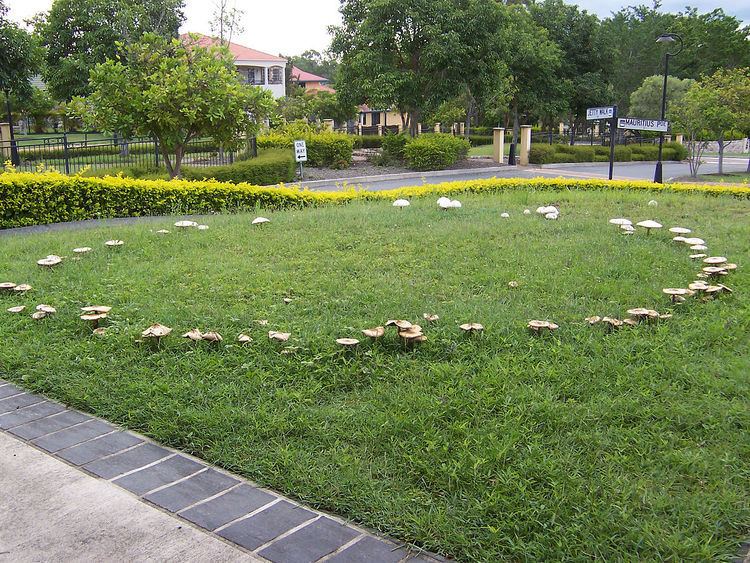 | ||
A fairy ring, also known as fairy circle, elf circle, elf ring or pixie ring, is a naturally occurring ring or arc of mushrooms. The rings may grow to over 10 metres (33 ft) in diameter, and they become stable over time as the fungus grows and seeks food underground. They are found mainly in forested areas, but also appear in grasslands or rangelands. Fairy rings are detectable by sporocarps in rings or arcs, as well as by a necrotic zone (dead grass), or a ring of dark green grass. Fungus mycelium is present in the ring or arc underneath.
Contents
Fairy rings are the subject of much folklore and myth worldwide—particularly in Western Europe. While they are often seen as hazardous or dangerous places, they can sometimes be linked with good fortune.
Genesis
The mycelium of a fungus growing in the ground absorbs nutrients by secretion of enzymes from the tips of the hyphae (threads making up the mycelium). This breaks down larger molecules in the soil into smaller molecules that are then absorbed through the walls of the hyphae near their growing tips. The mycelium will move outward from the center, and when the nutrients in the center are exhausted, the center dies, thereby forming a living ring, from which the fairy ring arises.
There are two theories regarding the process involved in creating fairy rings. One states that the fairy ring is begun by a spore from the sporocarpus. The underground presence of the fungus can also cause withering or varying colour or growth of the grass above. The second theory, which is presented in the investigations of Japanese scientists on the Tricholoma matsutake species, shows that fairy rings could be established by connecting neighbouring oval genets of these mushrooms. If they make an arc or a ring, they continuously grow about the centre of this object.
Necrotic or rapid growth zones
One of the manifestations of fairy ring growth is a necrotic zone—an area in which grass or other plant life has withered or died. These zones are caused by the mycelia which, during a very dry year, coat the roots of grasses and other herbs in meadows. After some time they are removed by biotic factors from the ground, at which stage a zone on the surface soil becomes visible. Patterns other than the basic ring or arc are also possible: circles, doubled arcs, sickle-shaped arcs, and other complicated formations are also formed by this process. Fungi can deplete the soil of readily available nutrients such as nitrogen, causing plants growing within the circle to be stressed which leads to plant discoloration. Some fungi also produce chemicals which act like hormones called gibberellins, which affect plant growth, causing rapid luxuriant growth.
Long-term observations of fairy rings on Shillingstone Hill in Dorset, England, further suggested that the cycle depended on the continuous presence of rabbits. Chalky soils on higher elevations in the counties of Wiltshire and Dorset in southern England used to support many meadow-type fairy rings. Rabbits crop grass very short in open areas and produce nitrogen-rich droppings. Mushrooms need more soil nitrogen than grass does. A ring can start from only a few spores from which the mycelium develops; the fruiting bodies of the mushrooms only appearing later, when sufficient mycelial mass has been generated to support them. Subsequent generations of fungi grow only outwards, because the parent generations have depleted their local nitrogen levels. Meanwhile, rabbits keep cropping the grass, but do not eat the fungi, allowing them to grow through their competition to tower, relatively, above the grass. By the time a circle of mushrooms reaches about 6 metres (20 ft) in diameter, rabbit droppings have replenished the nitrogen levels near the centre of the circle, and a secondary ring may start to grow inside the first.
Soil analysis of soil containing mycelium from a wood blewit (Clitocybe nuda) fairy ring under Norway spruce (Picea abies) and Scots pine (Pinus sylvestris) in southeast Sweden yielded fourteen halogenated low molecular weight organic compounds, three of which were brominated and the others chlorinated. It is unclear whether these were metabolites or pollutants. Brominated compounds are unknown as metabolites from terrestrial fungi.
Types
There are two generally recognised types of fairy ring fungus. Those found in the woods are called tethered, because they are formed by mycorrhizal fungi living in symbiosis with trees. Meadow fairy rings are called free, because they are not connected with other organisms. These mushrooms are saprotrophic. The effects on the grass depend on the type of fungus that is growing; when Calvatia cyathiformis is growing in the area grass will grow more abundantly; however, Leucopaxillus giganteus will cause the grass to wither.
Species involved
There are about 60 mushroom species which can grow in the fairy ring pattern. The best known is the edible Scotch bonnet (Marasmius oreades), commonly known as the fairy ring champignon.
One of the largest rings ever found is near Belfort in France. Formed by Infundibulicybe geotropa, it is thought to be about 600 metres (2,000 ft) in diameter and over 700 years old. On the South Downs in southern England, Calocybe gambosa has formed huge fairy rings that also appear to be several hundred years old.
